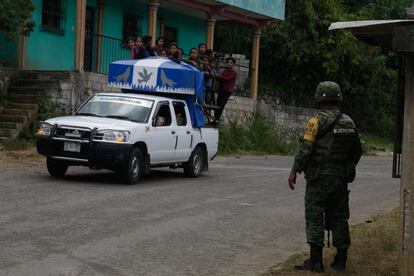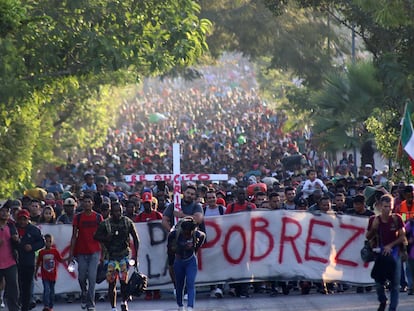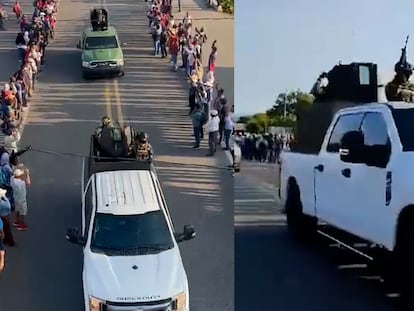Violence plagues Mexico’s southern border towns
Prosecutors in Chiapas maintain all is well, but residents have reported 20 murders by rival criminal gangs

Abandoned by their government, residents of southern Chiapas have been caught in a vicious crossfire between rival gangs battling for control of migrant trafficking, resource extraction, illegal drugs and other criminal activities. Pleas for help by municipalities like Chicomuselo, Frontera Comalapa and Amatenango have fallen on deaf ears, while dismissive officials claim all is well.
Towns like Grecia and Nueva Morelia exemplify the severity of the problem. In early January, residents of Nueva Morelia (Chicomuselo municipality) reported a clash between criminals that caused at least 20 deaths, including two innocent bystanders. According to a letter shared by the Fray Bartolomé De las Casas Human Rights Center, the gunfight lasted for seven hours. “We need help from the international community — they are killing us, forcing us from our homes, and making us join their gangs,” they implored.
Several videos on social media show alleged shootouts in Nueva Morelia and nearby areas on January 4, set against a backdrop of green hills and low-hanging clouds. A video shared on January 10 by Chiapas reporter Isaín Mandujano shows three armed boys in bulletproof vests firing shots in every direction as they run up and down the mountain shouting, “Puro Sinaloa, pura Mayiza! To hell with Mencho, up with the big M!”
Their shouts touted the Sinaloa Cartel and one of its long-time leaders, Ismael “El Mayo” Zambada. El Mayo, Mayiza, the big M is an elusive drug lord who has never been arrested or incarcerated. His former partner, Joaquín “El Chapo” Guzmán, is currently serving a life sentence for drug trafficking in the United States. Nemesio “El Mencho” Oseguera is believed to lead the rival Jalisco New Generation Cartel (CJNG), which has been expanding across Mexico for years.
People in this area are used to seeing videos like these. In the last 10 years, videos of Mexico’s shootouts have circulated widely on social media, far beyond its borders. They have been downloaded countless times to phones and tablets along with more innocuous material. The normalization of violent content is half-heartedly countered by the government’s photos and videos depicting peace and quiet throughout the land.
That’s exactly what Chiapas officials did four days after the video of the kids shooting in the mountains emerged. “The [Chiapas] State Attorney General’s Office is announcing that collaboration among all government levels have ensured peace and resident safety in Chicomuselo municipality... To this end, citizens’ complaints have been promptly addressed to clarify the situation in different areas of the municipality. It is important to reiterate that there have been no reports of homicide due to any confrontations in the municipality of Chicomuselo.”
The Chiapas State Attorney General’s Office goes on to note that the recent reports are nothing more than “misinformation.” This statement raises questions about what would motivate local residents to spread misinformation, considering that similar incidents have occurred throughout Chiapas for years. Reading between the lines, it seems the focus is more on the absence of formal homicide complaints than actual incidents. The prosecutors did not say whether their conclusions were based on thorough investigations.
The situation in Nueva Morelia and the neighboring community of Grecia is dire. Residents and non-governmental organizations in the two mountain communities have reported that criminal gangs are trying to exploit the economic void left by two companies that used to mine the area’s plentiful barite. The mineral is used in oil well drilling and in car paint, according to the Ministry of Economy. A Mexican company and later a Canadian company called Blackfire began mining barite in the early 2000s, but were later shut down.
Residents’ protests against the irregularities in concession and exploitation procedures received little attention. It was only in 2009, following the murder of community leader Mariano Abarca, that the government terminated the mining concessions citing environmental concerns. This was detailed in a report by the International Work Group for Indigenous Affairs (IWGIA) that also revealed how criminal gangs have attempted to fill the void after the mines were closed.
According to the IWGIA report by indigenous law expert Elisa Cruz, criminal groups coerce and threaten residents, social organizations and municipal officials to gain control over land and mining activities. “In early 2023, armed men saying that didn’t belong to any mining company visited representatives of Nueva Morelia,” said Cruz. “They informed everyone that they planned to take the barite Blackfire left in Nueva Morelia and proceeded to steal the mineral.”
Sign up for our weekly newsletter to get more English-language news coverage from EL PAÍS USA Edition
Tu suscripción se está usando en otro dispositivo
¿Quieres añadir otro usuario a tu suscripción?
Si continúas leyendo en este dispositivo, no se podrá leer en el otro.
FlechaTu suscripción se está usando en otro dispositivo y solo puedes acceder a EL PAÍS desde un dispositivo a la vez.
Si quieres compartir tu cuenta, cambia tu suscripción a la modalidad Premium, así podrás añadir otro usuario. Cada uno accederá con su propia cuenta de email, lo que os permitirá personalizar vuestra experiencia en EL PAÍS.
¿Tienes una suscripción de empresa? Accede aquí para contratar más cuentas.
En el caso de no saber quién está usando tu cuenta, te recomendamos cambiar tu contraseña aquí.
Si decides continuar compartiendo tu cuenta, este mensaje se mostrará en tu dispositivo y en el de la otra persona que está usando tu cuenta de forma indefinida, afectando a tu experiencia de lectura. Puedes consultar aquí los términos y condiciones de la suscripción digital.
More information
Archived In
Últimas noticias
Aquilino Gonell, former Capitol sergeant: ‘If it hadn’t been for the police, the US would be a dictatorship’
A hybrid building: Soccer pitch, housing, and a shopping mall
Europe urges Trump to respect Greenland following annexation threats
Science seeks keys to human longevity in the genetic mixing of Brazilian supercentenarians
Most viewed
- Alain Aspect, Nobel laureate in physics: ‘Einstein was so smart that he would have had to recognize quantum entanglement’
- Mexico’s missing people crisis casts a shadow over World Cup venue
- Why oil has been at the center of Venezuela-US conflicts for decades
- Trump clarifies who is ultimately in charge in Venezuela: ‘Me’
- Mexico seeks to shore up its defenses following US incursion in Venezuela











































